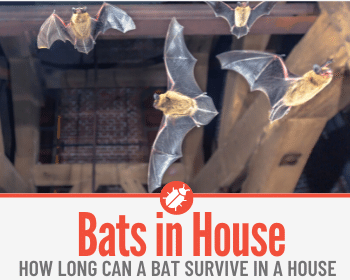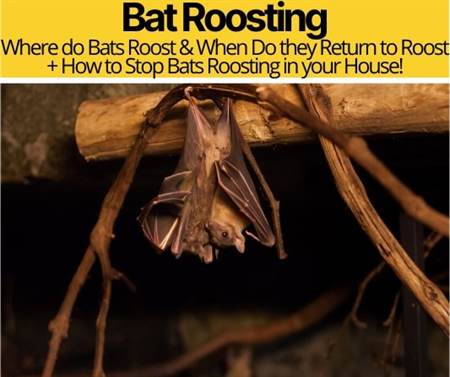 Suspecting a bat in your house? Not Sure How Long Can Bats Survive and live in your house?
Suspecting a bat in your house? Not Sure How Long Can Bats Survive and live in your house?
In this guide you will learn:
- Common Signs of Bats in your House & what Attracts them,
- How Long Can a but Live in your house or basement,
- How Long can a Bat Survive in a House Without Food or Water,
- What to do about Trapped Bats or Dead bats in Walls
Having a bat in your house can not only be terrifying but have dangerous health effects on the human residents.
Not only are the bats themselves carriers of disease, their waste can also carry similar fatal diseases that can be passed to humans.
Bats can go undetected for years, hiding and living in the attic or basement of your house in areas you are not likely to check.
Over time they can make their way into the walls of your house, and cause unexpected issues.
Here is how to tell, and what to do.
Signs of a Trapped Bat in your House
Some of the signs of a bat roost in your home would be:
- the smell of ammonia from bat urine,
- droppings piled in corners of their residence or on windowsills,
- staining on the walls from urine,
- and the slight scratching and squeaking sounds coming at night when they are active.
Bats oftentimes get into a house by loose siding on buildings, chimneys, and basements.
They can travel through the walls of the home, however in order to locate the entry point into their nest you want to look for a buildup of black discoloration that looks similar to an oil streak.
Should I be Worried About Bats Living in my House?
Yes, inside your house the bats do more harm than good.
The accumulation of bat droppings can increase your chances of being infected, and the size will increase the likelihood of encountering an infected or aggressive bat.
The more bats you have occupying the roost the more likely you are to encounter a dead bat as well.
Bats can oftentimes move throughout the house, getting trapped in air vents as well as walls.
This would increase a number of issues which we will discuss in depth later in the article.
Read More: What Time Do Bats Return to Roost
How Long can a Bat Live in a House?
Bats inside a house with stable access to a local food and water source will live their full life expectancy.
Many different species of bats however have different needs, with some hibernating or migrating during specific times of the year.
This makes it harder to detect if you don’t occupy the home year round.
However, a bat that begins to roost will almost always be within a gap wall, or an enclosed dark space in the house that does not gain much attention for the safety of their young.
This means basements and attics being primary targets for bats.
If you see a bat in your house, please leave the room immediately and contact your local wildlife specialist. As mentioned before, bats can carry diseases.
Not only that, there are reports of people attempting to encourage the bats to leave through a window only for it to crawl into the wall or escape further into the house.
How Long can a Bat Survive in a House Without Food or Water?
Without food or water, a bat will die within twenty four hours, making it important to contact your local wildlife specialists immediately.
Assuming the bat has been captured, is hurt, or is In a place you can not access you should follow the protocol listed in this article and not touch it.
- An agitated bat is more likely to harm and infect you.
- If there are no local laws regarding bats in your area, please seek an exotic vet.
- Transport the animal wearing thick gloves and a face covering.
- If you are bitten or scratched, seek medical assistance immediately.
How Long can a Bat live in a Basement
Assuming the bat has sought shelter that meets the requirements above, it will almost always match the description of your basement, cellar, or even attic ,meaning they can live in your basement for their full life.
These areas in themselves have a high concentration of insects due to the area not having a lot of human traffic, or other predators.
Once a bat has decided to roost in your basement it will return no matter what.
While species may have different patterns of migration and hibernating, they are all usually creatures of habit with remarkable memory.
A single bat can have four children per year, with life spans decades long.
A roost can easily triple in size if left unattended for even a short amount of time.
Some species of bats actually prefer living in houses, which can be an issue if not dealt with correctly.
What should you do If there are Bats in your Walls?
The chances of a bat roost leading to a bat in the wall are high, although there are a couple other reasons you may have a bat in your walls.
Bats can slip into a space as small as 1/4th of an inch.
This means there are many entry points for a bat to enter, so don’t be alarmed as this does not always mean a bat has started to roost.
If you hear or see the bat, do not attempt to remove it yourself.
Removing the bat yourself means you are endangering your own health and adding unnecessary expenses to your issue.
What does a Dead Bat in the House Mean
A dead bat is another sure sign of bat activity in your area, and a possible roost in your home.
It’s quite easy to locate the carcass as they give off a sickening aroma from the methane gas and sulfur dioxide released.
Bats are usually a protected species, so if you see a dead or dying bat it is in your best interests to take a photo so it can be identified by a wildlife specialist at a later date.
Some bats can carry diseases that can indicate how their population is doing.
Other diseases, such as rabies which is carried by bats can stay alive temporarily after its host has passed.
Removing the Dead Bad from your house or walls…
If it is in an area that requires it to be removed, please wear gloves and bag the bat.
If you suspect the dead bat is within your walls you should call a local wildlife animal excavator.
Safety of Living in House with Bats
Fortunately bats can not damage the infrastructure of the home as severely as other pests have been found to be able to. With that being said the accumulation of bat droppings from their nest can damage the walls as well as insulation.
Health issues from a bat roost can be severe. Bat dropping contains a range of diseases transmissible to humans, including lung disease.
While bats are not aggressive, a frightened and trapped bat can attack you and can infect you with rabies. Rabies treatments vary upward of ten grand, so every bat you see should be treated with the utmost caution. T
his being said, it is not in your best interest to allow bats to roost in your home.
What Attracts a Bat to your House?
Bats look for the same things as any mammal: A place plentiful in food and water, with a quiet space to raise their young.
They are particularly attracted to low light areas.
Attics and Basements are common, quiet roosting spots for bats. A heavily planted garden can also attract them to your area, as this means a wide variety of food for them.
A roost can begin even with only two entry points, which can easily be found in the loose panelling on the side of your house.
Bats eat a variety of food; including plants, leaves, insects, and some have a larger appetite consisting of small animals.
The average bat can eat almost three thousand insects a night, making them very active and voracious hunters.
Bright lights and fake owl decorations will keep them away.






